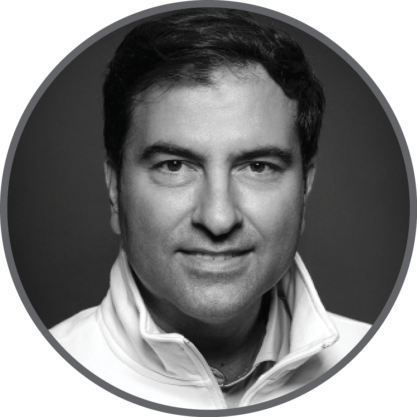
Dr. Ianchulev is the Director of Ophthalmic Innovation and Technology at the New York Eye and Ear Infirmary of Mount Sinai and a Professor of Ophthalmology at Icahn School of Medicine at Mount Sinai in New York.
1. What drew you to ophthalmology and, specifically, to glaucoma?
I grew up in communist Bulgaria on the other side of the “curtain” 20-plus years ago, where medicine was more of a public service than private practice and most physicians, while underpaid and overworked, were passionate and selfless about their work. This was the case for my mother, a retina surgeon who, for many years, was the chief of a hospital department of ophthalmology and a univeristy professor. She was not only a clinician and academician but also an inventor herself, having developed one of the first IOLs used in Eastern Europe. I spent time with her and her patients, and I fell in love with the medical field.
But I was an impatient and wayward teenager, and I did not want to grow in the shadow of my parents in Bulgaria. So, when the Berlin Wall fell and the borders opened, I escaped to the United States with just $200 in my pocket to pursue my undergraduate studies. While at Harvard Medical School, I had to choose a specialty and initially was drawn to obstetrics and gynecology. Then I fell under the influence of Anthony Adamis, MD, a cornea specialist at Massachusetts Eye and Ear. Ultimately, I realized that I liked the precision and technology of ophthalmology as well as the blend of surgery and primary care. My mother exposed me to the field, but working with Tony and being influenced by his innovative nature closed the deal.
My interest in glaucoma was not immediate, either. In fact, of all the ophthalmic subspecialties, my initial inclination was against glaucoma because it was so imprecise. At the time, the results of visual field testing and trabeculectomy were inconsistent, variable, and rather subjective. I saw glaucoma as the unsophisticated relative of cataract and refractive surgery, and I had little affinity or patience for the inherent “defocus” in its clinical paradigm. That all changed when I met Donald Minckler, MD, a prominent glaucoma specialist and former editor of Ophthalmology. Working with Don was an eye-opening experience, and it was partly because of his mentorship that I started to embrace glaucoma. Then, early in my career, I met other glaucoma specialists such as Thom Zimmerman, MD; Robert Stamper, MD; Dunbar Hoskins, MD; Brian Francis, MD; and others, who were all very bright, thoughtful, and committed to the field. They reminded me of the passionate Bulgarian doctors, my mother included, who inspired me as a child.
Clearly, my trajectory highlights the influence of the people we meet along our career paths and the importance of mentors over subject matter. Although I did not initially intend to specialize in ophthalmology or glaucoma, I recognized that these spaces presented opportunities to try to solve the challenges that frustrated me yet also motivated me to invest myself in the solution. Sometimes taste is acquired—mine for both ophthalmology and glaucoma certainly was.
2. Of the many innovations you have pioneered in ophthalmology, is there one of which you are most proud?
Certain innovations are closer to my heart and feel more nostalgic than others, partially because I was so young when I was involved with them and partially because I was so lost at the time and lacked the wisdom of experience. The two projects I remember most fondly are the inventions I worked on as a resident, when I had just a few resources beyond grit and ingenuity.
In my last 2 years of residency, I worked on the first technology for intraoperative aberrometry, which currently underlies the ORA System (Alcon). My collaborators and I essentially leveraged autorefractor technology and brought it into the OR to develop something new. We stumbled upon this discovery and persevered until the idea became a reality.
The other memorable invention I worked on in residency involved perimetry. At the Los Angeles county hospital, many patients had to wait 3 to 4 months for perimetry. Additionally, the test itself presented numerous challenges. My coresident, Dr. Peter Pham, and I came up with the idea of a virtual perimetry device. We were able to create an emulation of the Humphrey visual field (Carl Zeiss Meditec) and shrink it to pure software that could be installed on any computer or run through the internet. We were able to achieve almost 90% sensitivity and specificity for detecting moderate and advanced defects in comparison to Humphrey visual field testing. It made us question the need for big, bulky hardware when it could instead be virtualized.
To my knowledge, ours was the first virtual device that could be used to scan the visual field and create a contrast sensitivity map. Twenty years later, during the COVID-19 pandemic, we are utilizing this technology for remote patient monitoring. Although we started this project 20 years ago, we persisted, and our idea is finally aligning with the times.
Overcoming these challenges motivated me to continue focusing on innovation from a young age. When I talk to medical students and residents today, I tell them they don’t have to wait to pursue a discovery. I discovered the syndrome of optic neuropathy from propionic aciduria (on which we published in Ophthalmology) by virtue of seeing a few patients and conducting a study as a resident. Innovation is not always about access to funding but about a willingness to endure some sleepless nights turning over an idea. Everyone, regardless of their age, should feel encouraged to follow their ideas and convert them into solutions.
3. The invention process is often a long and expensive one. What keeps you motivated?
I like to say that my perimetry index is on the optimistic side and that I have a rather prominent selective scotoma to the insurmountable challenges of innovation. Our perimetry project took 20 years to become relevant. Had we focused too intently on the many obstacles that existed, we might have been deterred from seeing it through. Challenges will always be a part of the invention process and, many times, if we truly knew what it would take, we would never do it. Selectively “tuning out” the hurdles, fear, and prospects of failure can be an invaluable skill for every innovator. However, this should not be an excuse to ignore real challenges and to not be ferociously and inexorably searching for the ground truth, the root cause, and the utility function of innovation, while constantly pressure-testing our assumptions.
4. What are your goals for the next few years?
I have multiple goals and am currently involved in a number of projects. As it stands, robotics is majorly underutilized in ophthalmology. We are significantly behind other specialties, yet our field is all about precision. At the New York Eye and Ear Infirmary—with the extraordinary support of Chairman Dr. James Tsai, Dr. Louis Pasquale, and the entire faculty—we deployed the first US system for robotic ophthalmic surgery and successfully developed the first-ever module for robot-assisted goniosurgery and MIGS stent implantation, which we are preparing to use clinically. I see robotics as the way of the future with great potential to transform several ophthalmic subspecialties.
In addition to robotics, I am working hard to change the 100-year-old eye drop paradigm. Conventional eye droppers can overdose the eye by as much as 300%, more than 50% of administrations touch the ocular surface, and many patients struggle to administer their drops properly and/or adhere to their prescribed regimens.1,2 Collectively, these challenges prevent many therapeutics from reaching their full efficacy and safety.
At Eyenovia, we are using high-precision, piezo-print technology to deliver microdoses of ophthalmic medication. Our Optejet platform is being investigated as a way to address several significant problems in eye care, including the global epidemic of progressive myopia. We are hopeful that our ongoing phase 3 investigation can bring a therapeutic to slow progressive myopia by close to 70% based on the data so far. We also have a phase 3 program investigating the use of this technology for microdosing pilocarpine for presbyopia.
The resurrection of virtual perimetry for remote monitoring is also very exciting to me. A lot of this work can be done on the backbone of AI. The convergence of digital diagnostic tools, remote monitoring, and AI can open the door to scalable exponential health technologies, which are the best way to address public health and population health. I expect significant progress to occur in these areas, which is very satisfying to me as an ophthalmologist and public health specialist.
5. When was the last time glaucoma surprised you? How?
Glaucoma continues to surprise me in that the field is not moving quickly into areas of major potential impact. Home monitoring technology is one example. Practitioners have access to digital platforms for assessing perimetry, tonometry, and optic nerve health, yet we evaluate these metrics every 3 to 6 months and miss 99% of the “picture.” A major breakthrough will occur when we take disease-monitoring technology out of the physician’s office and into patients’ homes and smartphones. I predict that we will start to see movement in this area soon, as other fields show us the path forward.
Overall, it has always taken a surprising amount of time for the paradigm in glaucoma to change. MIGS, for example, has completely transformed care—but I wish it hadn’t taken decades. I guess this is one difference between innovation and research: Innovators are impatient!


